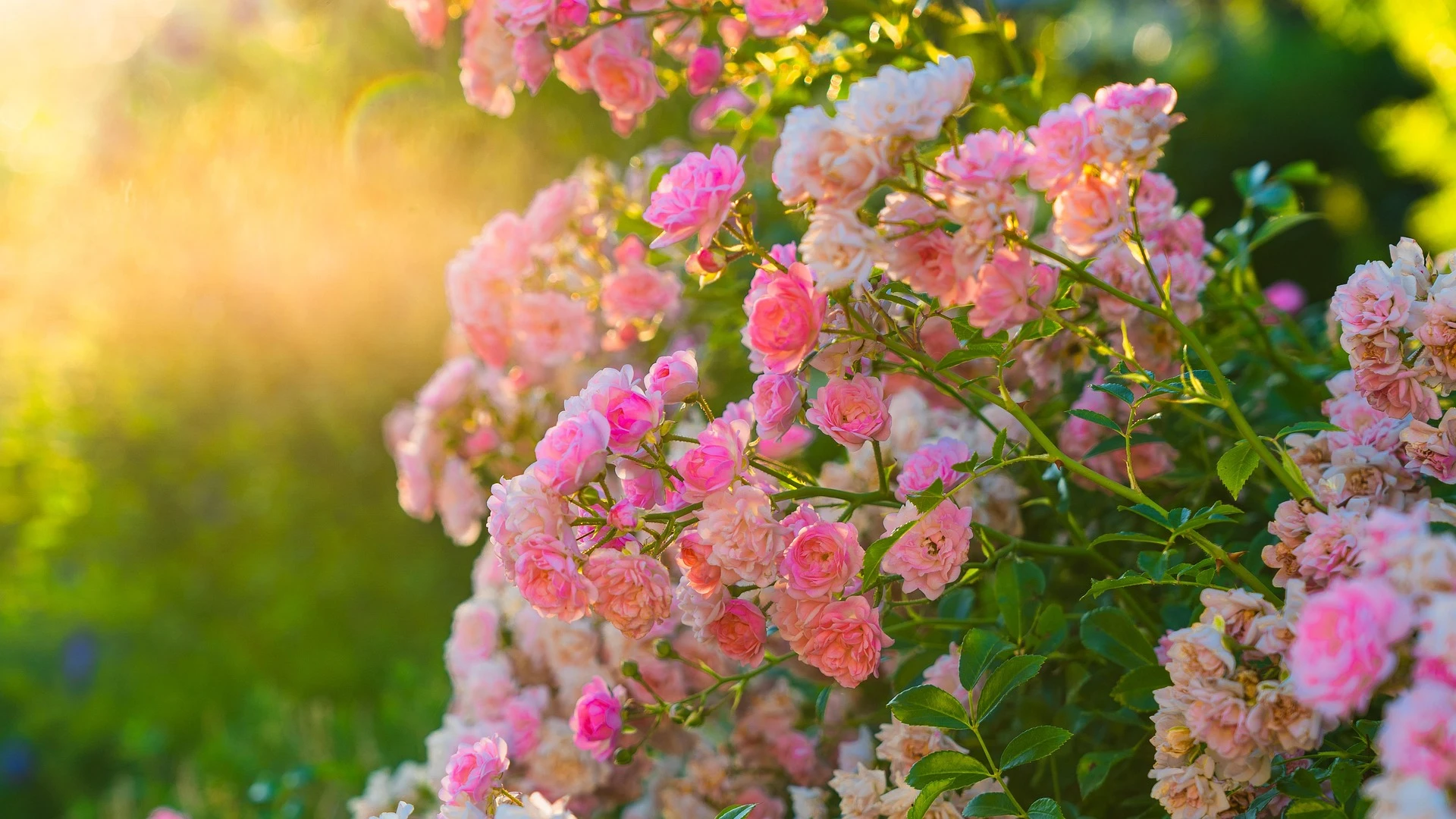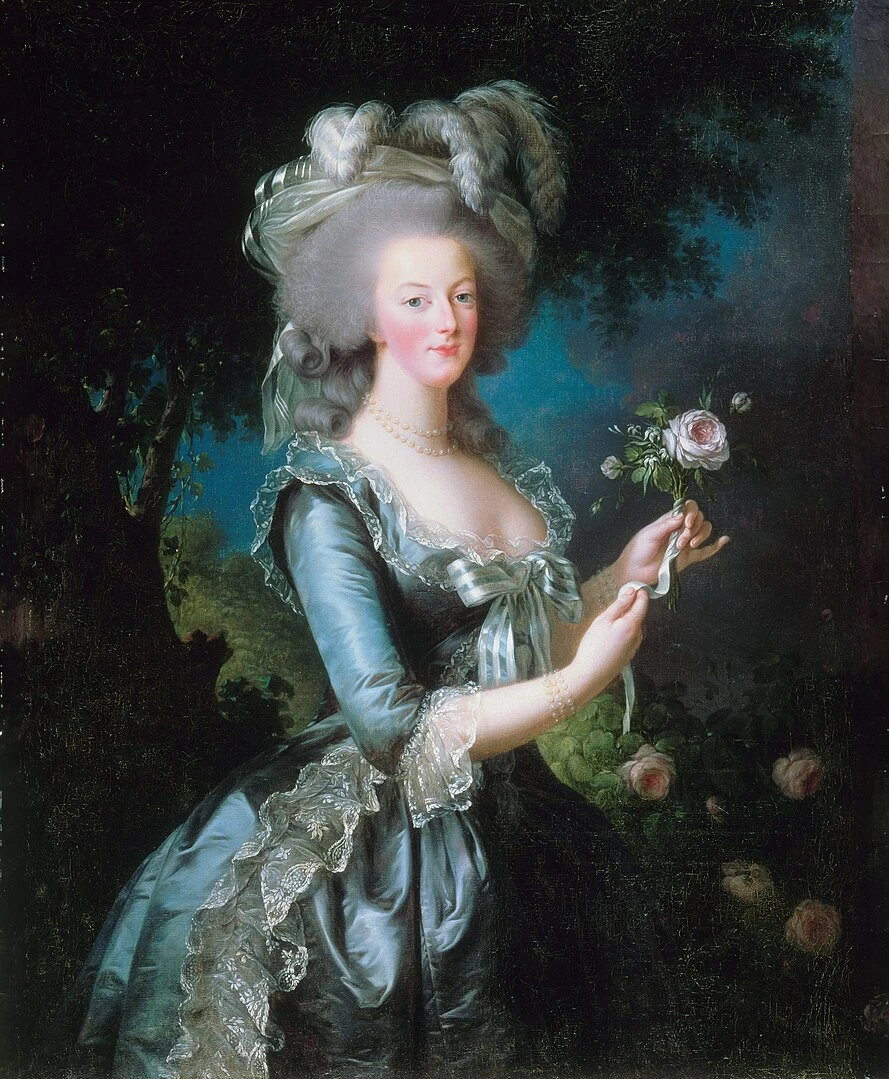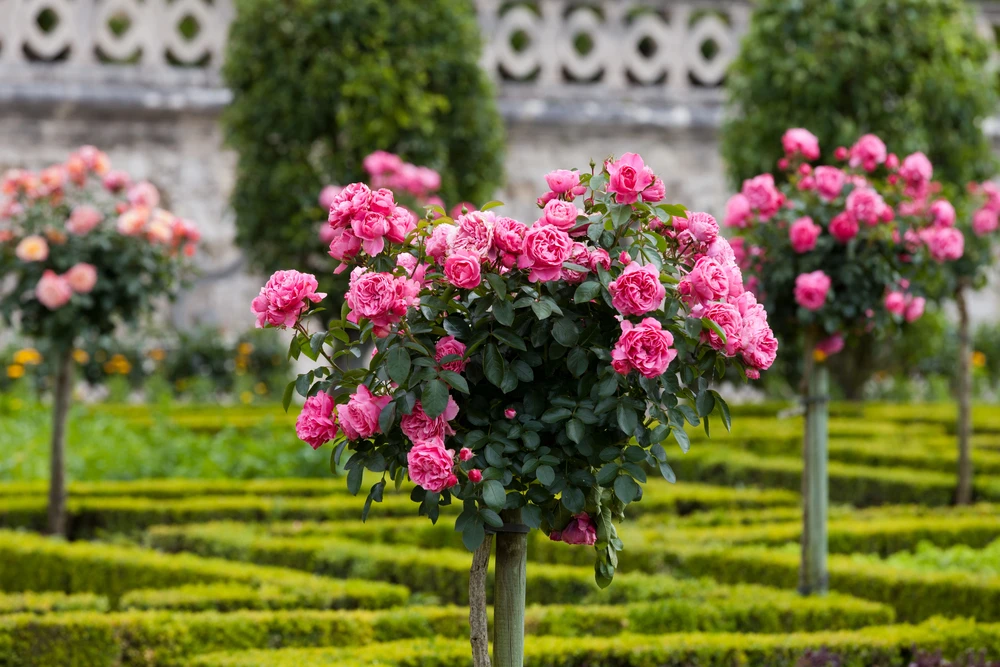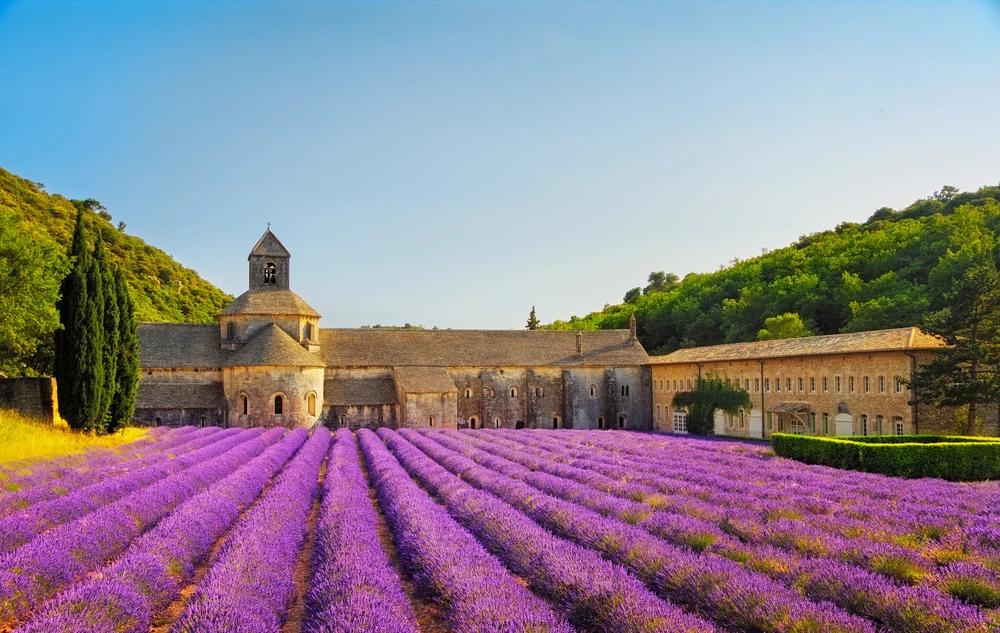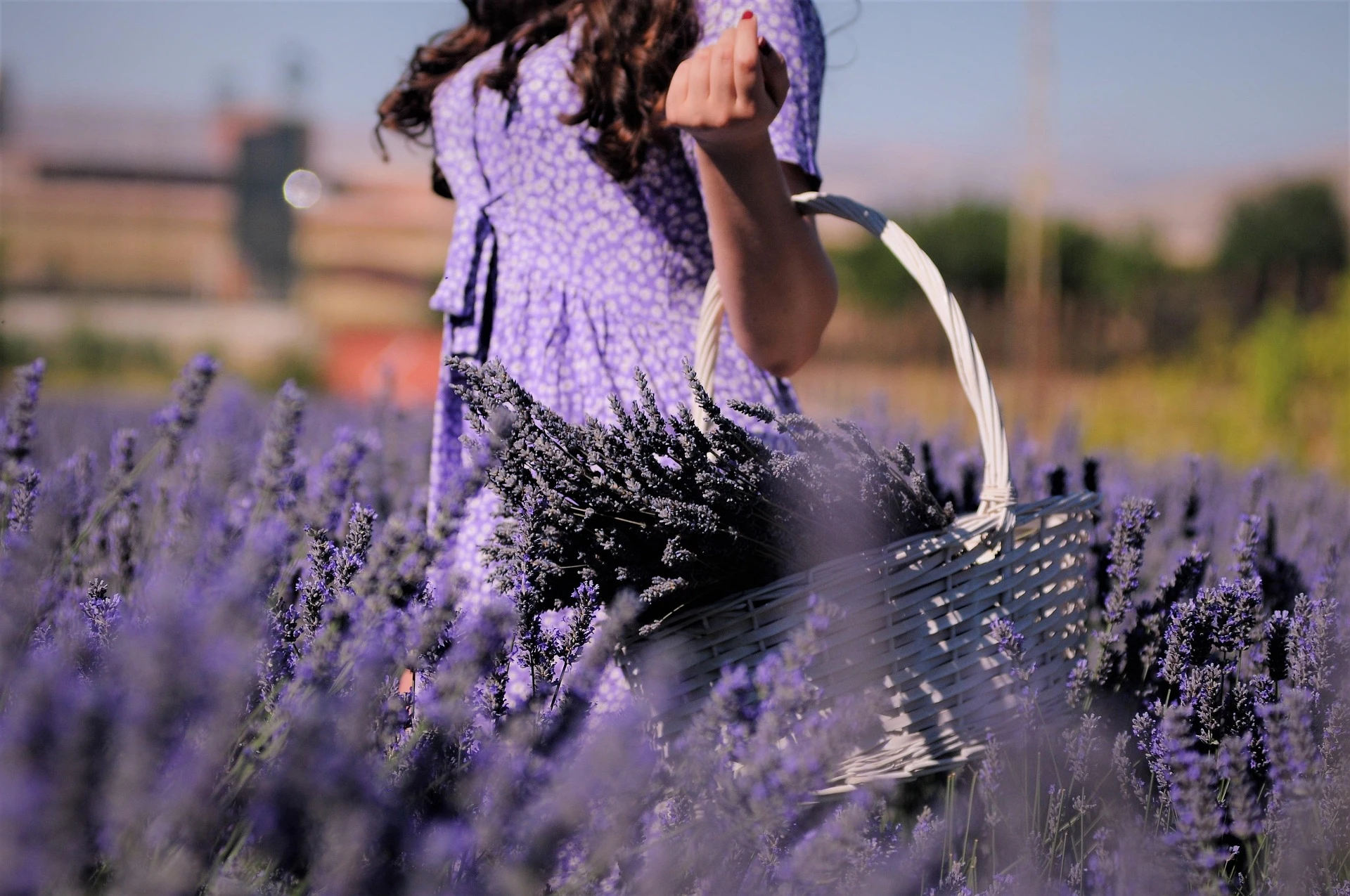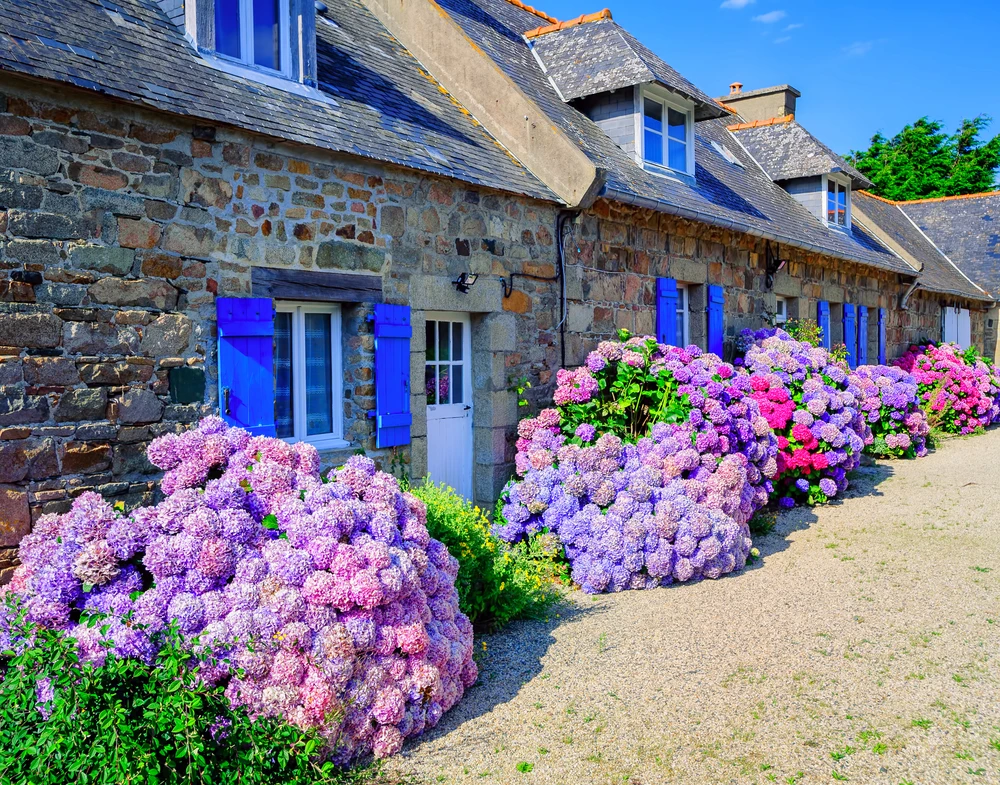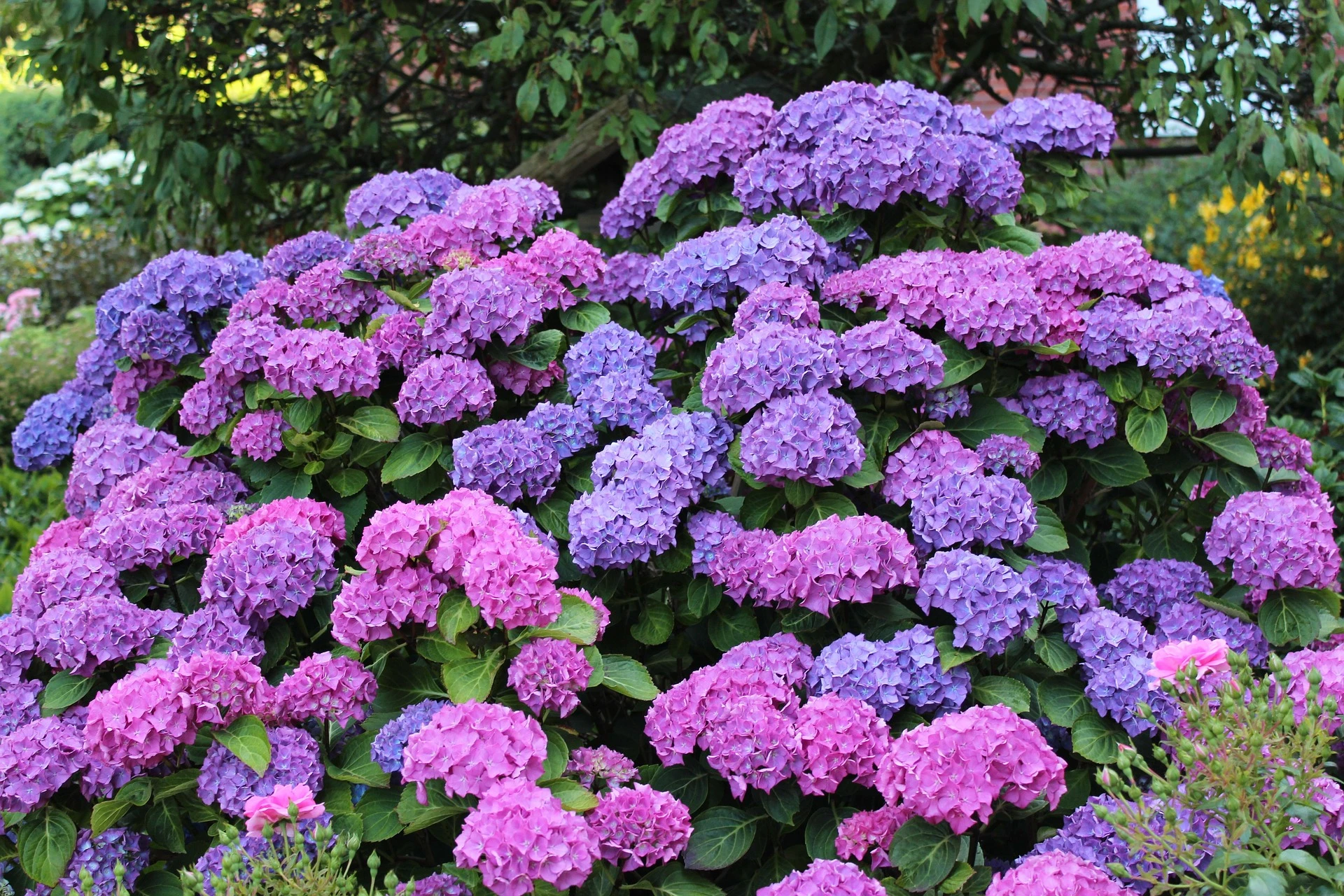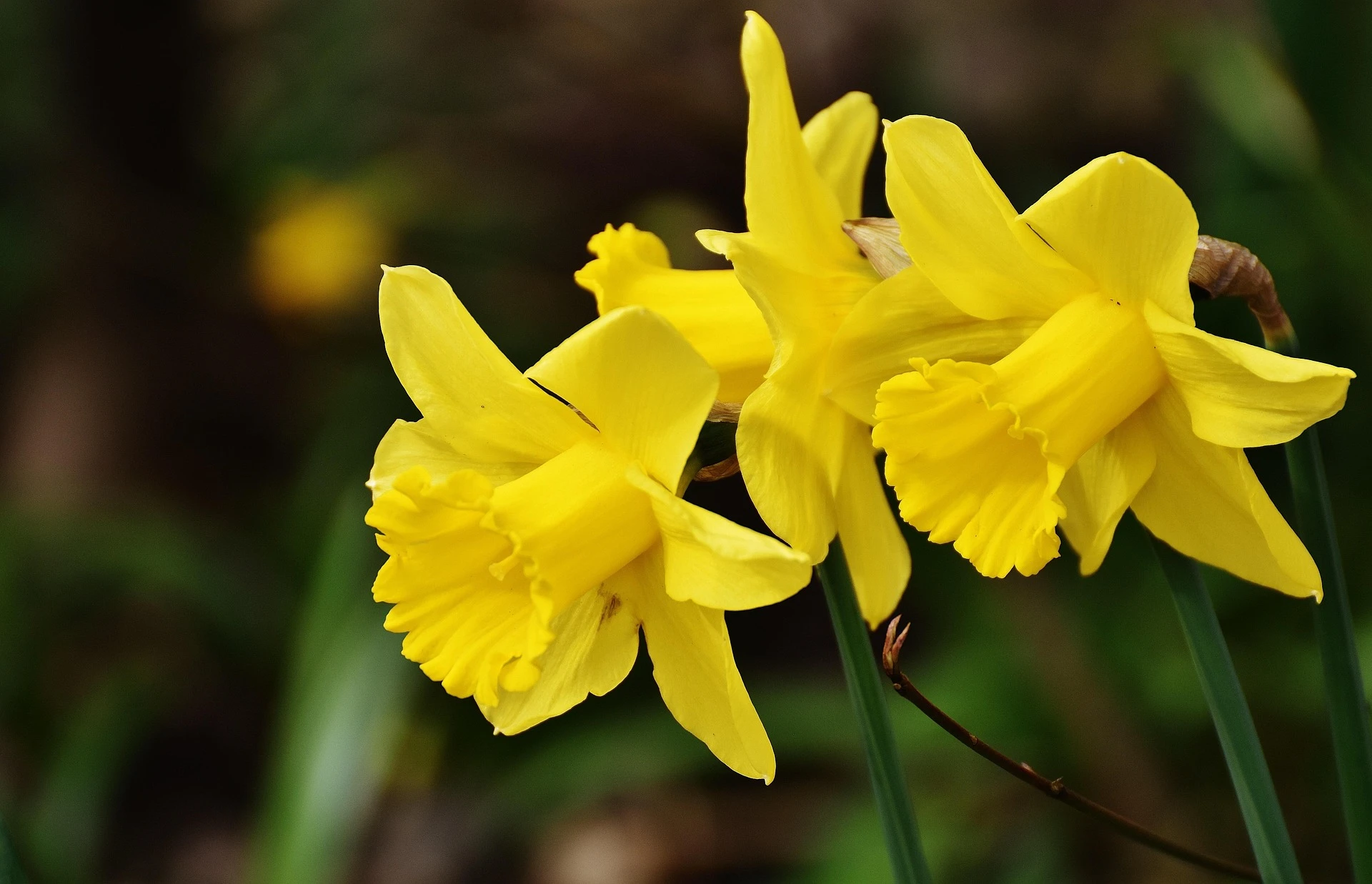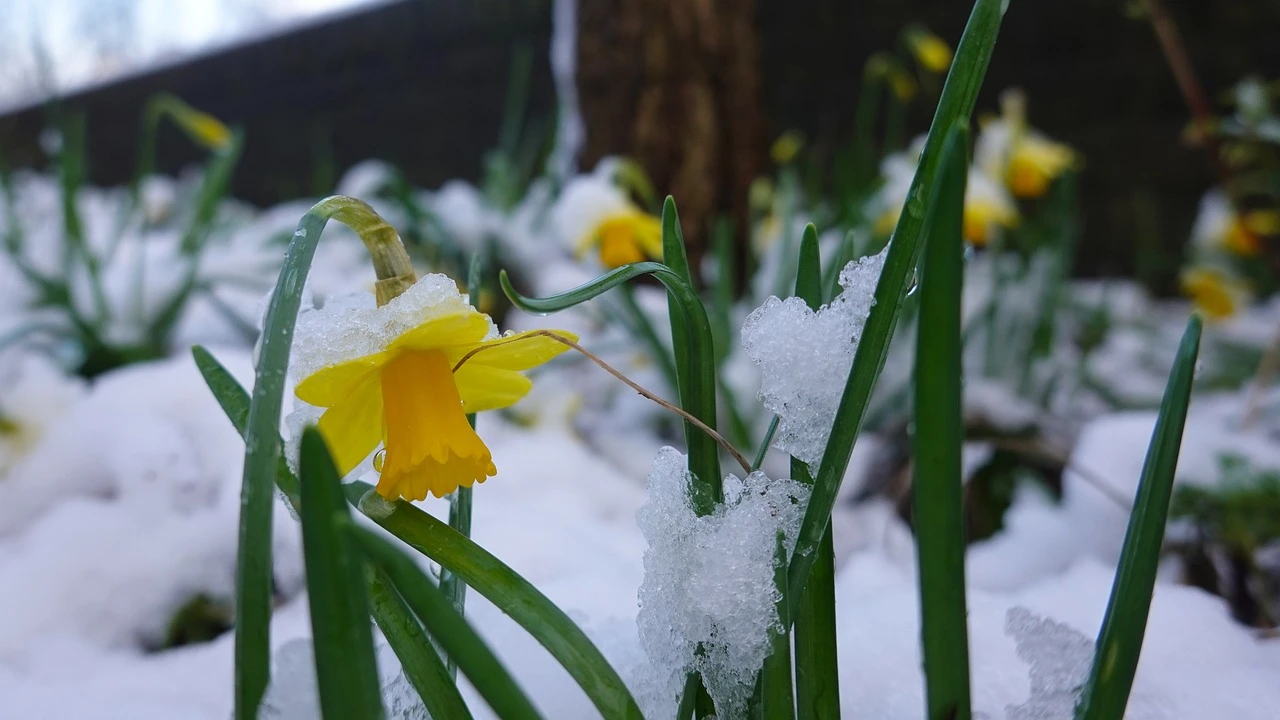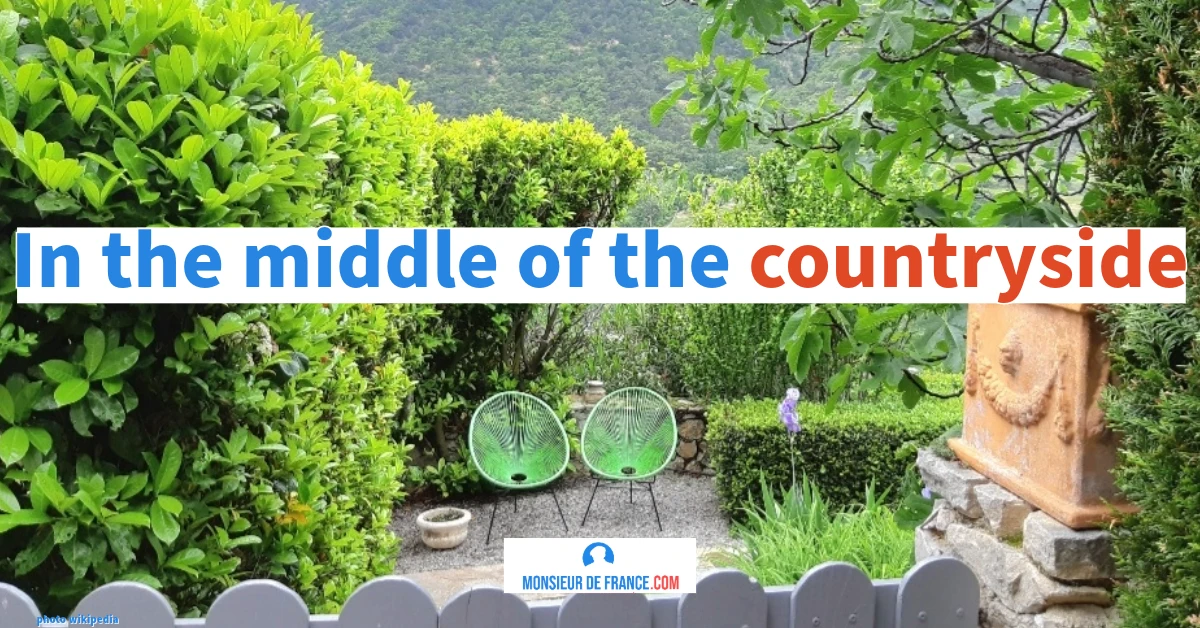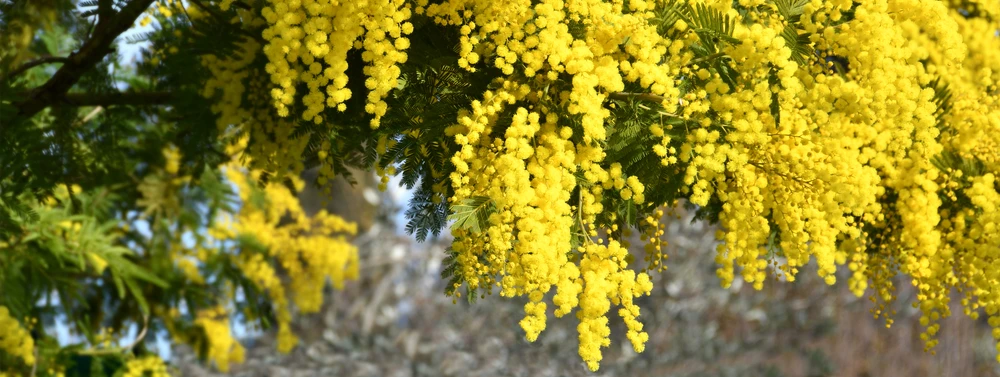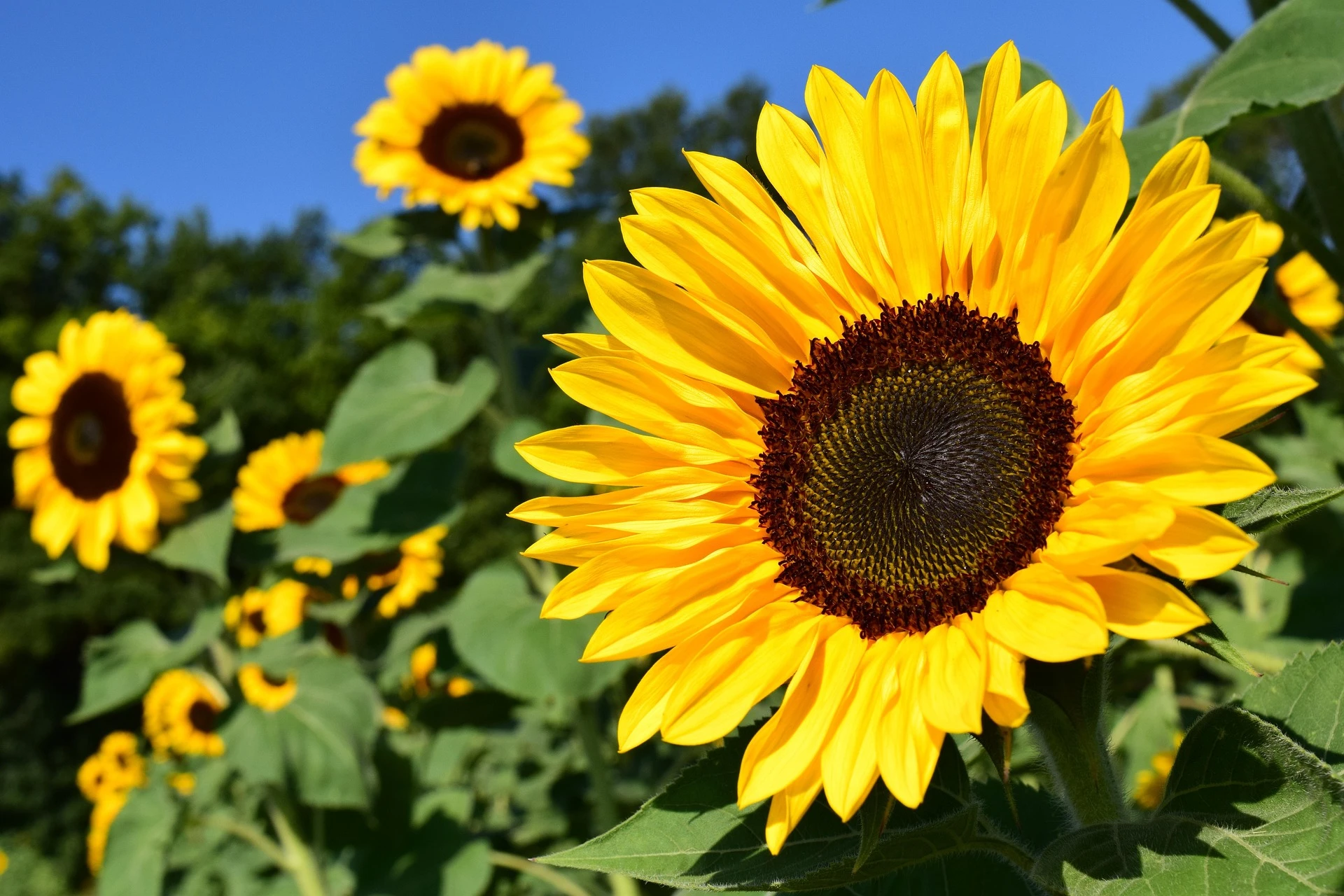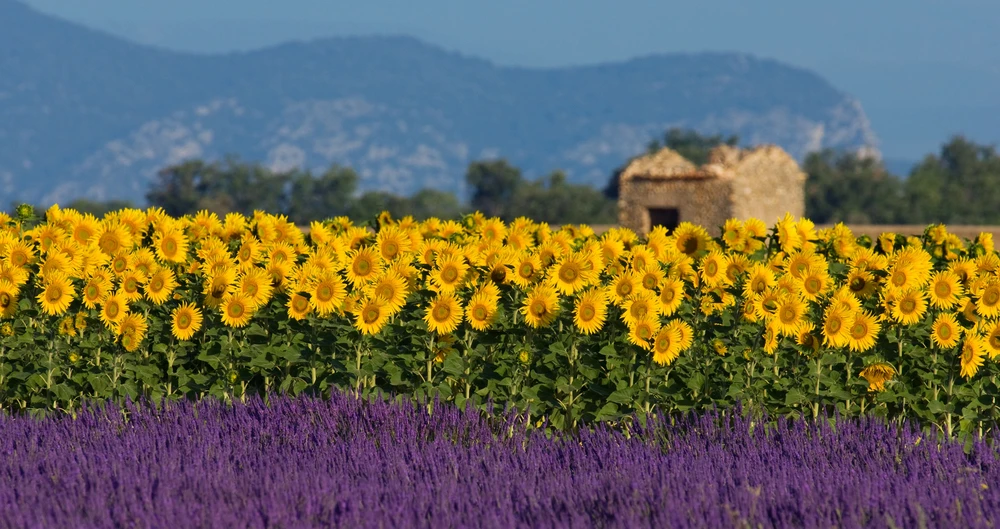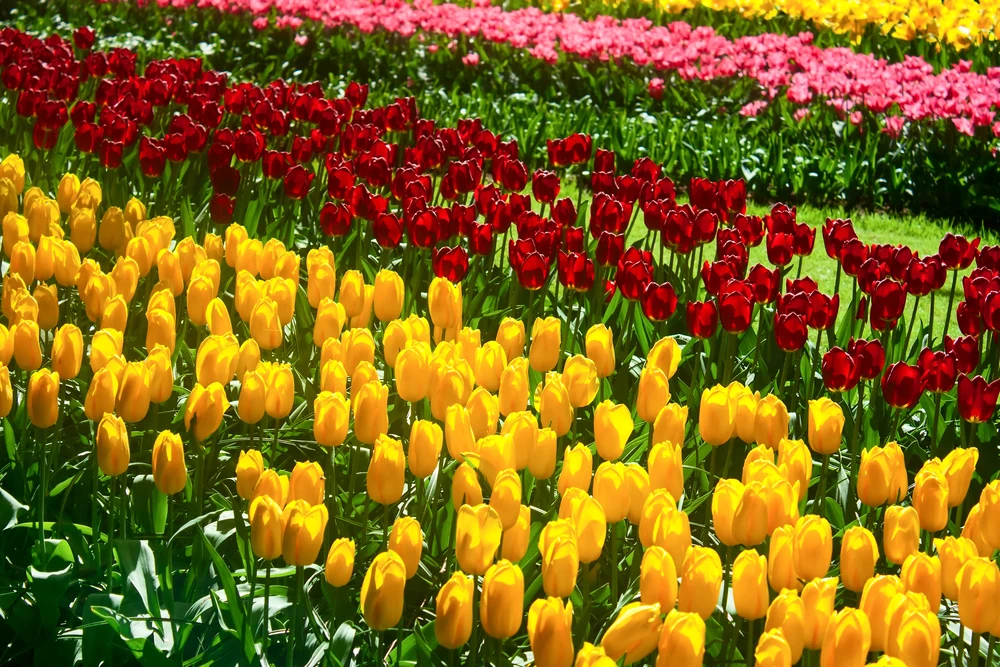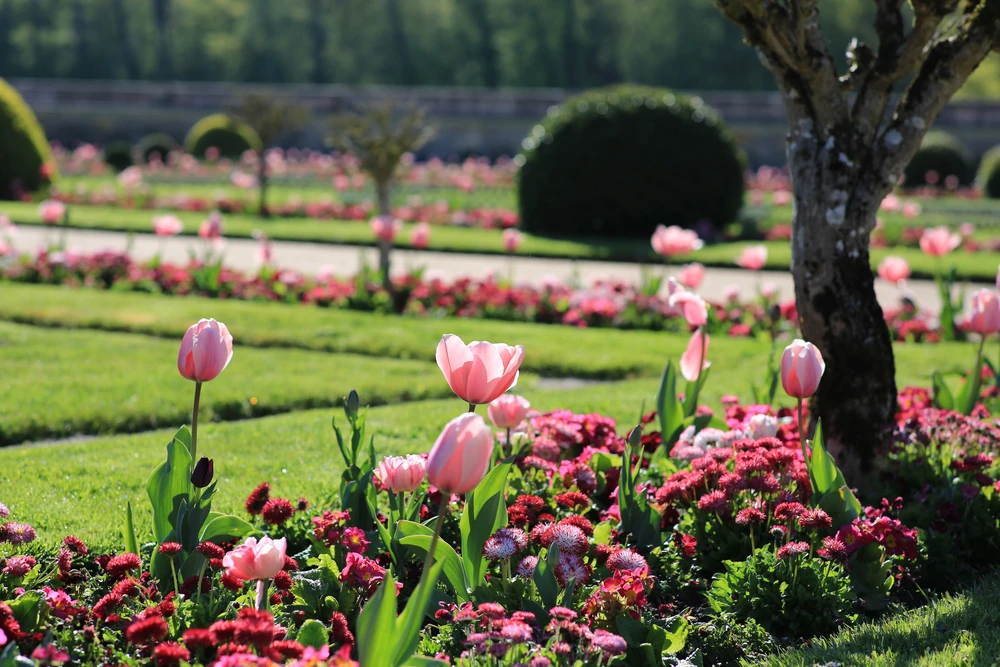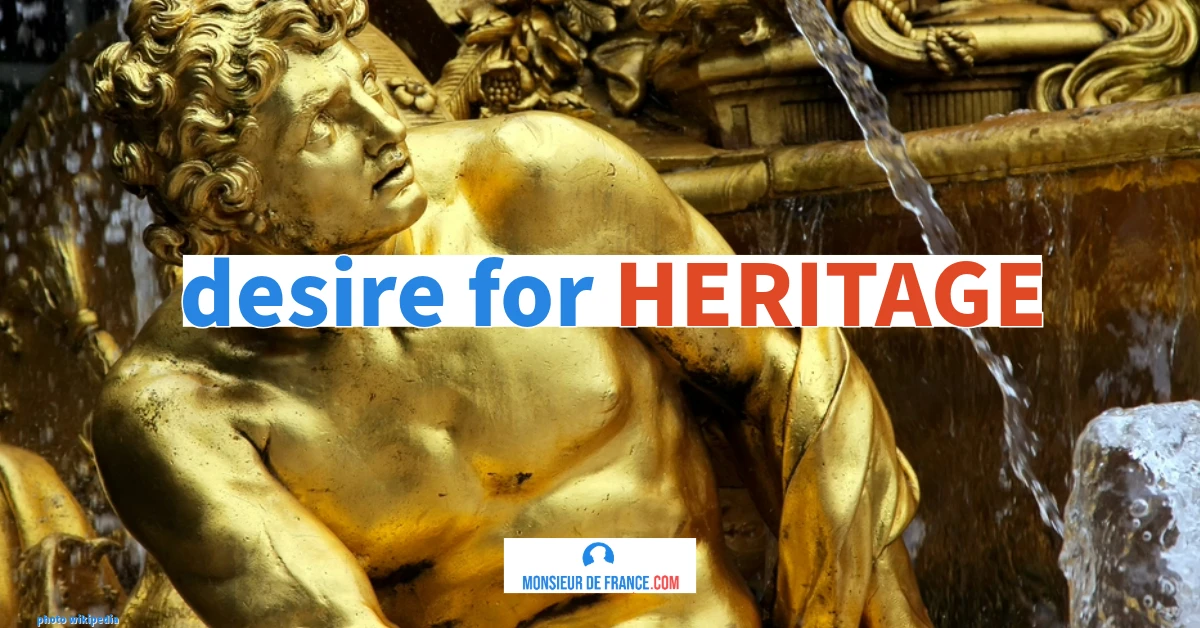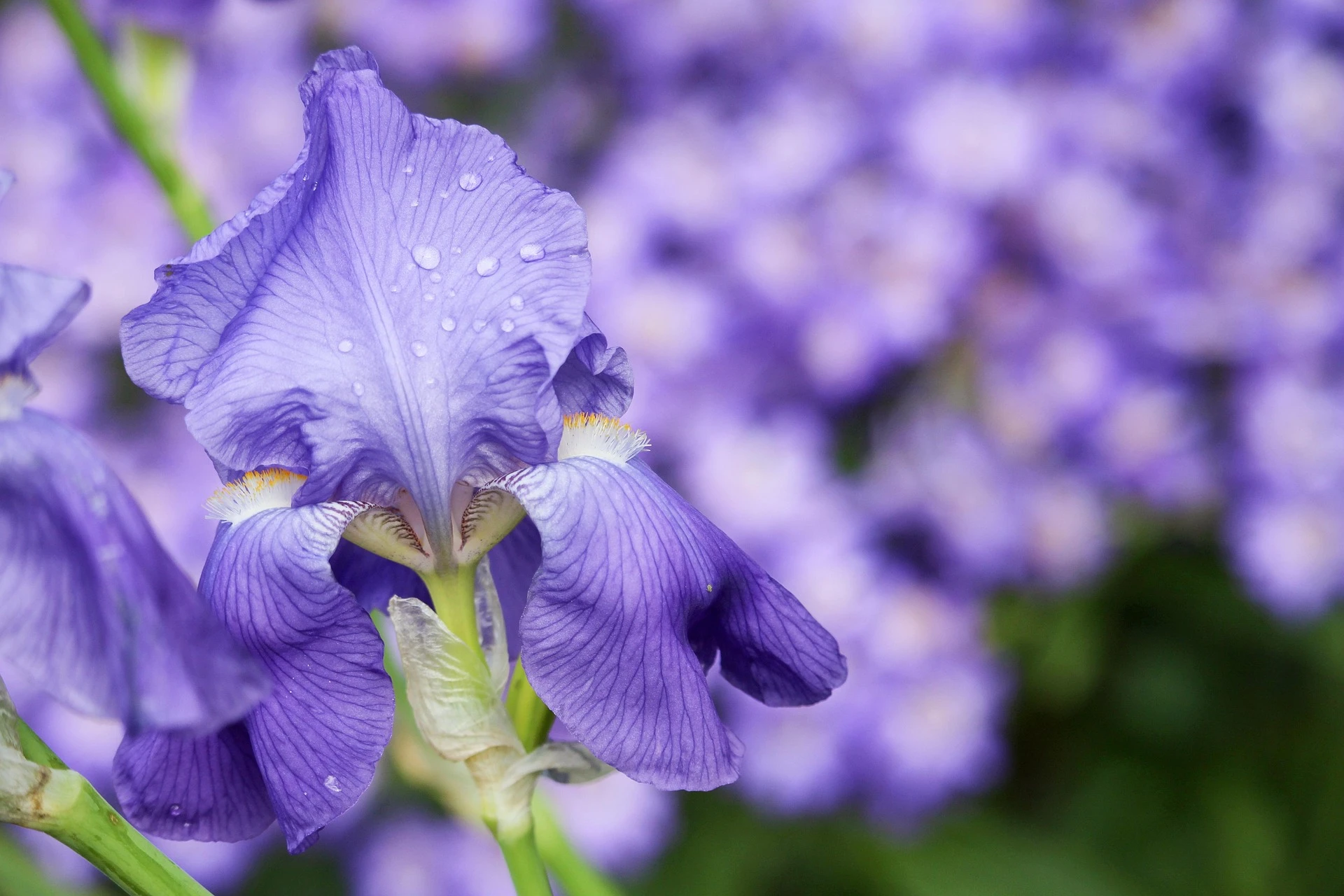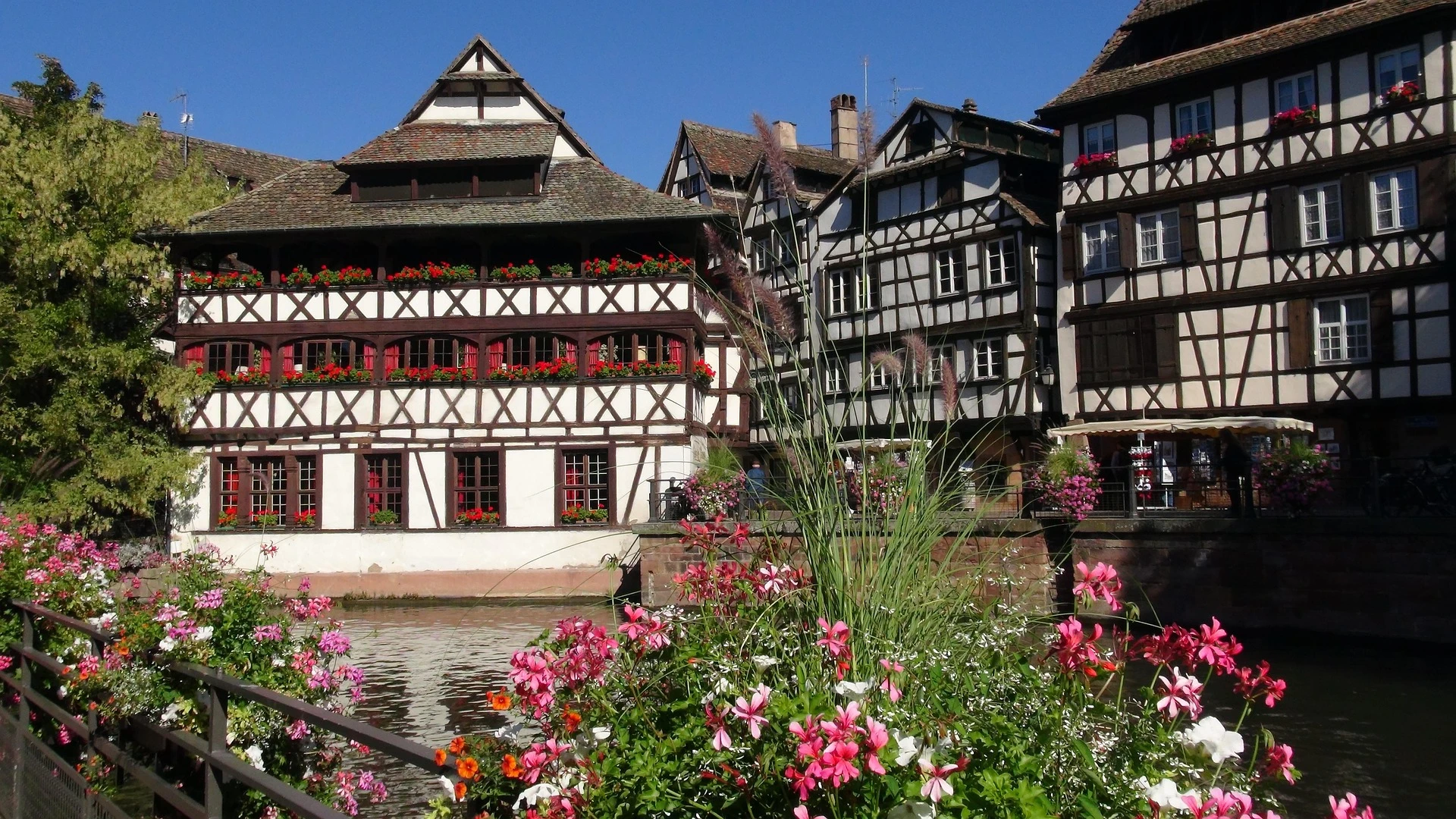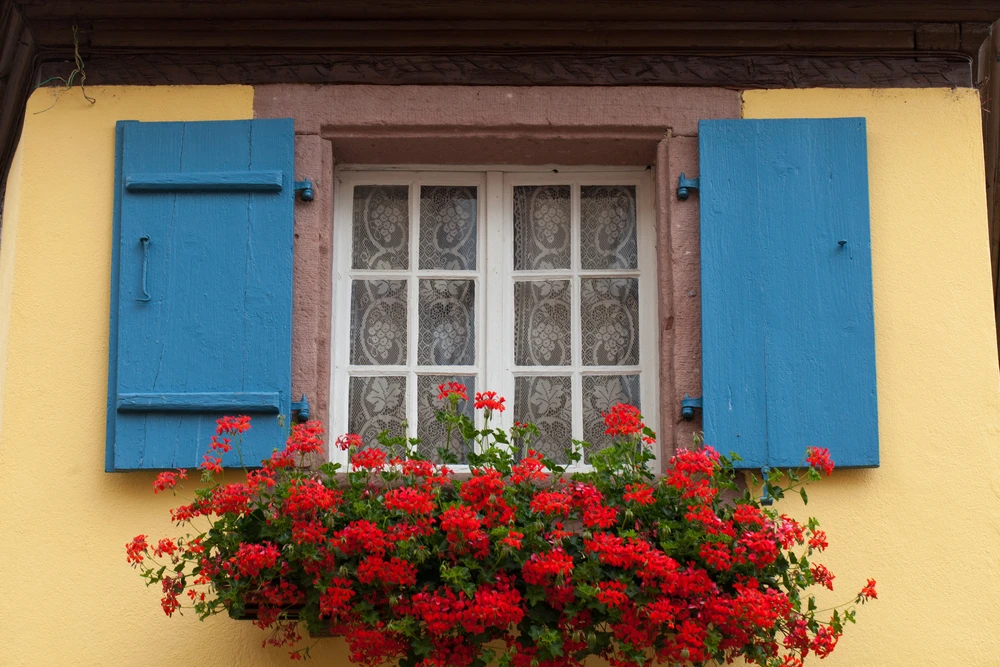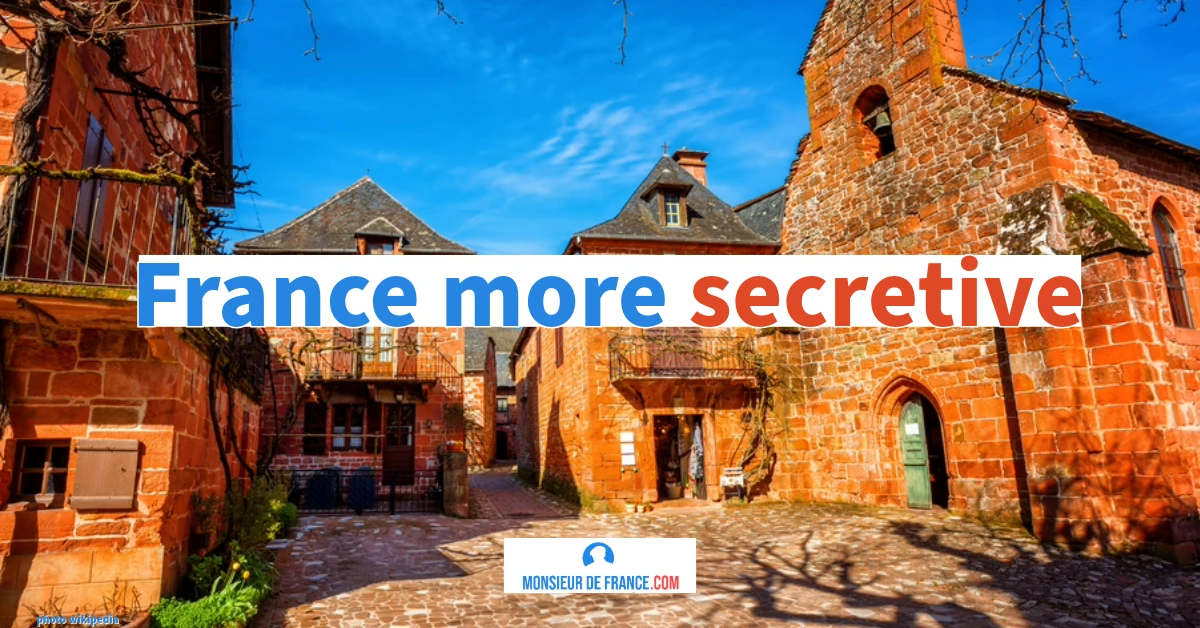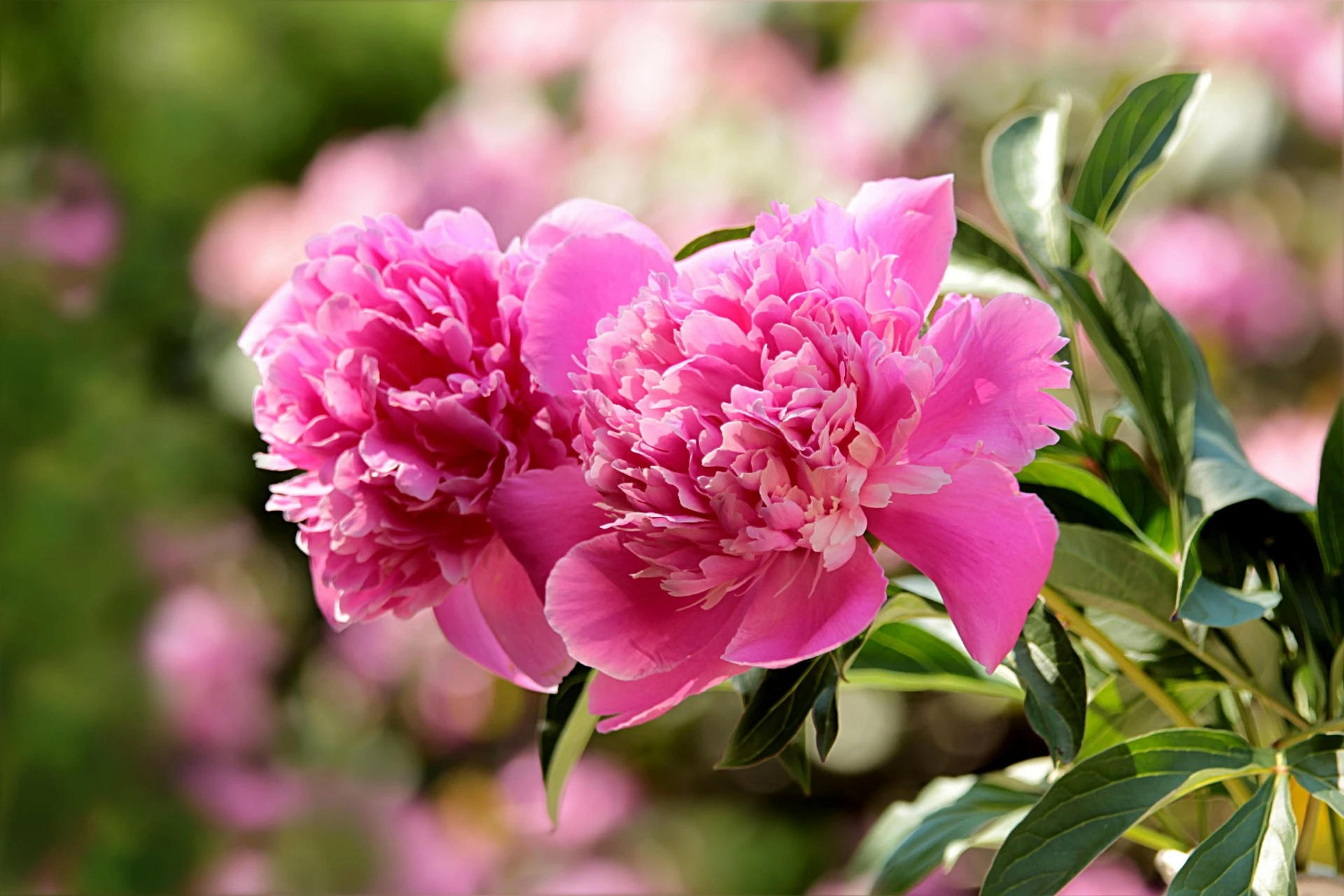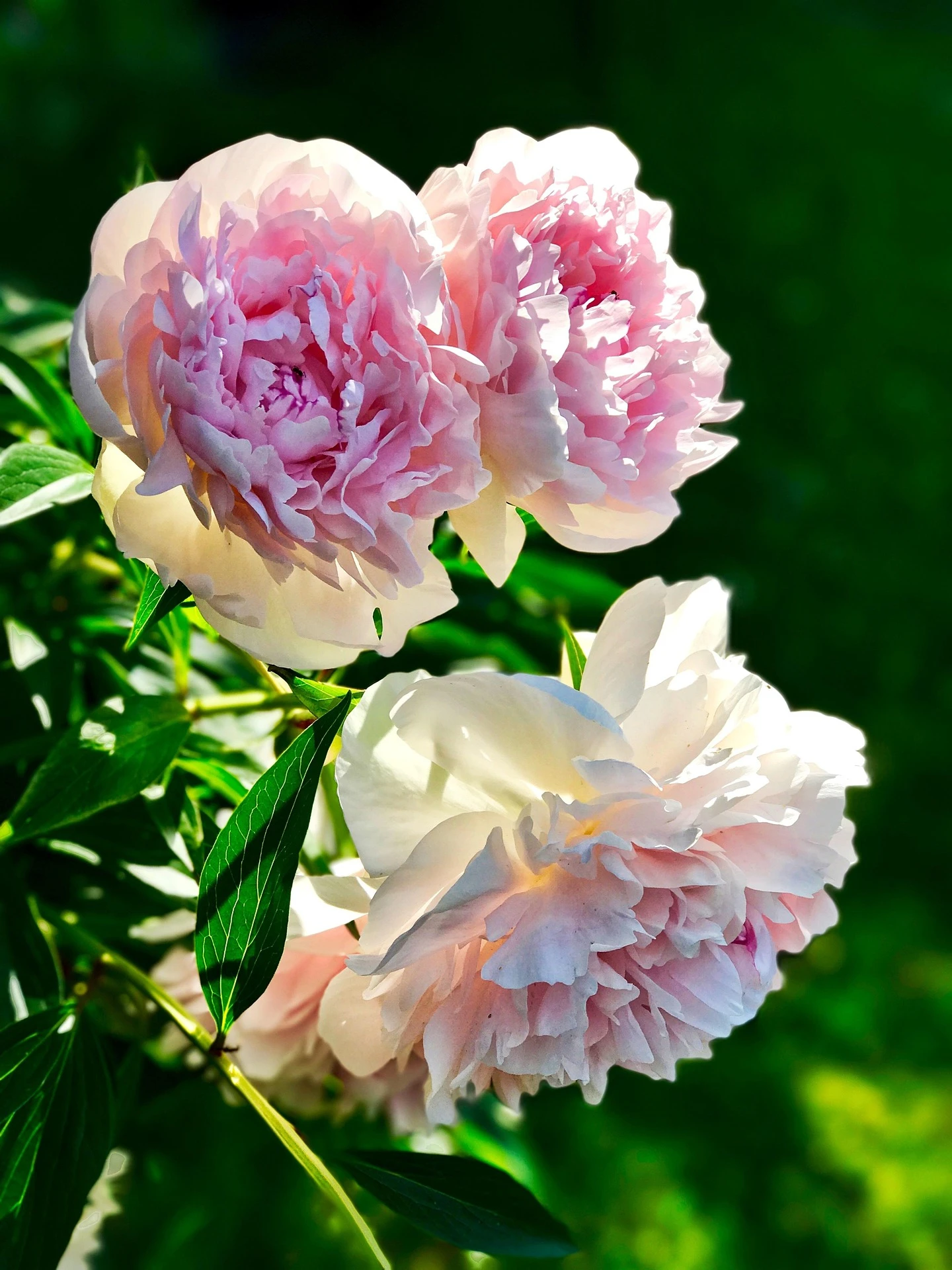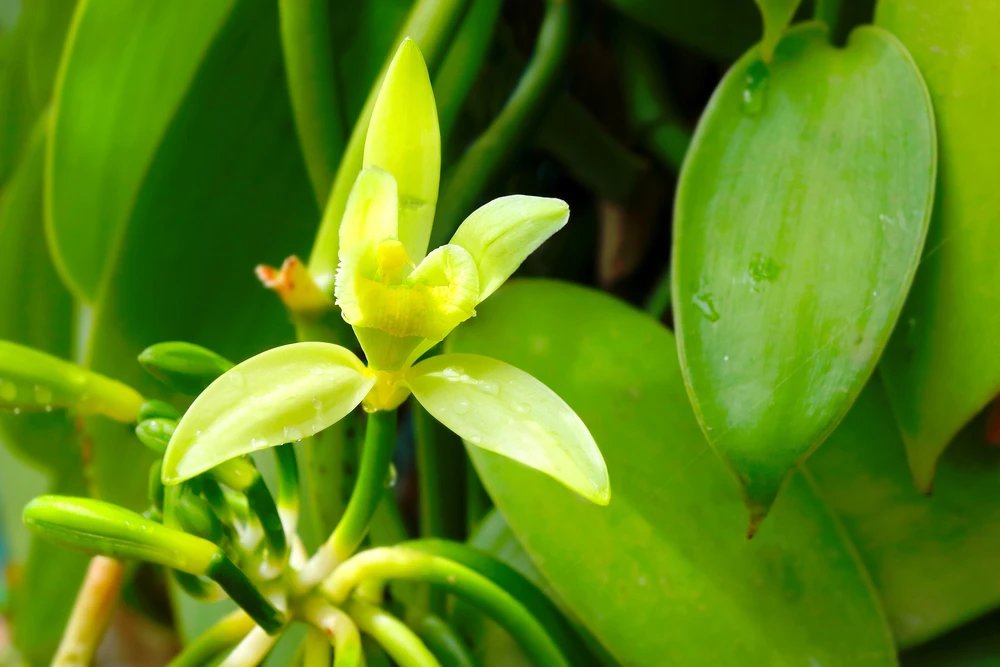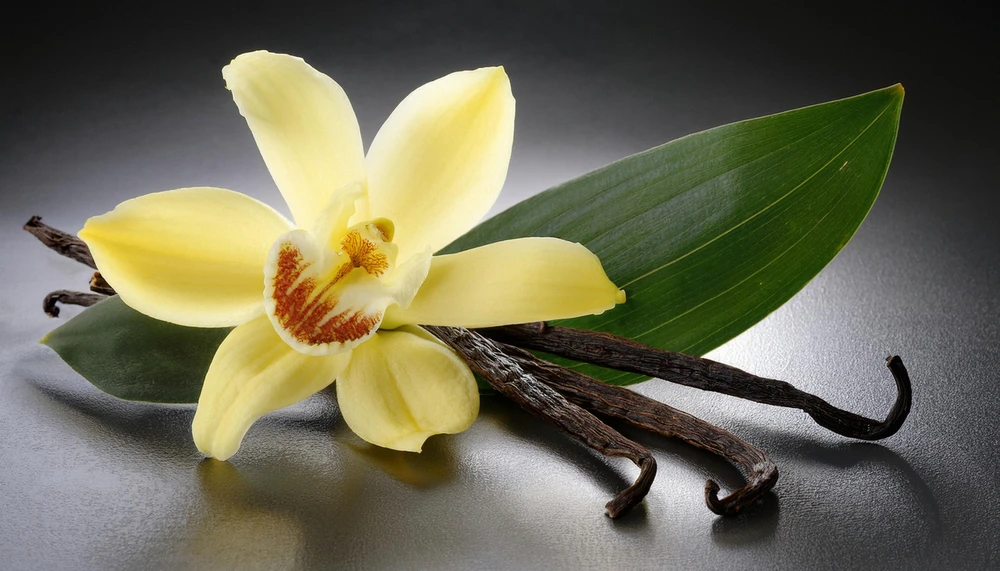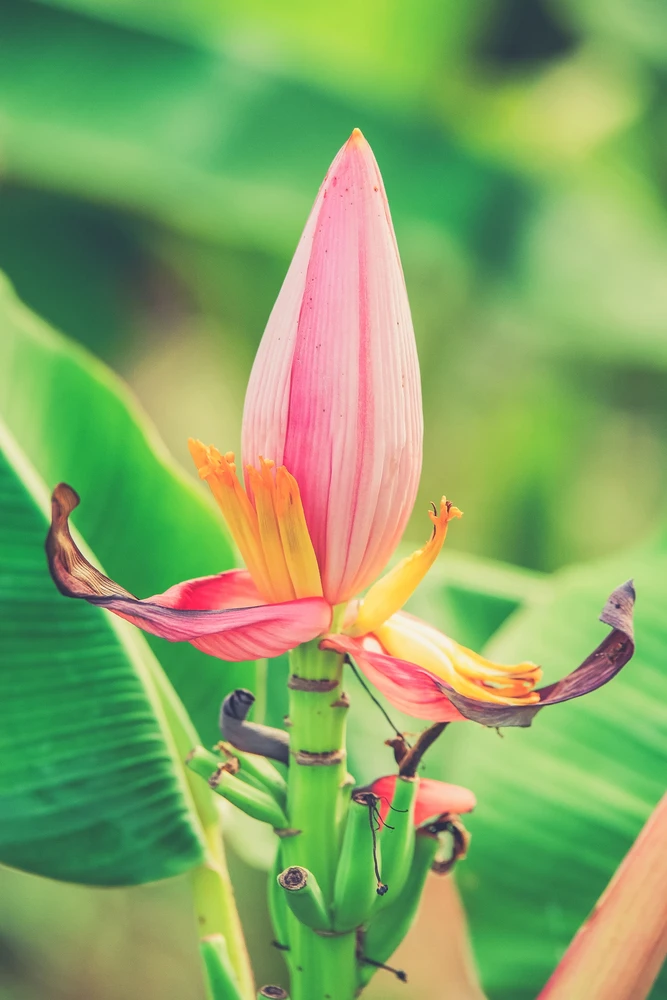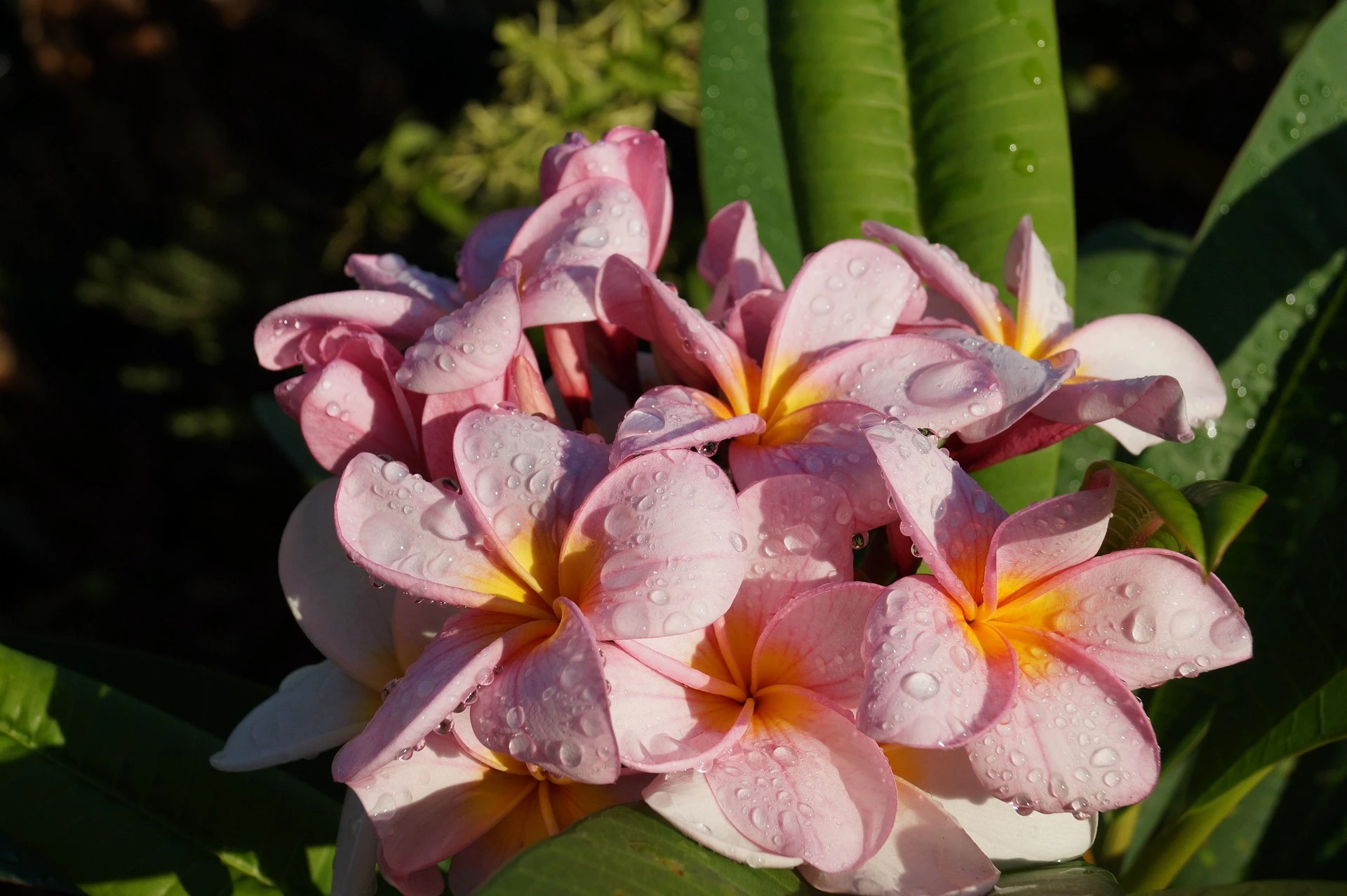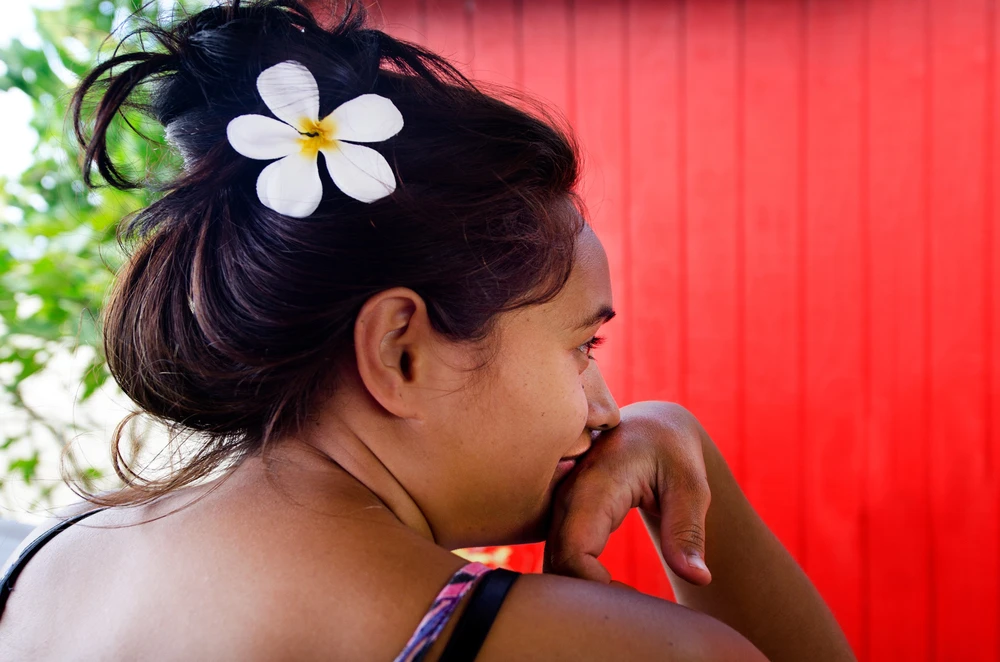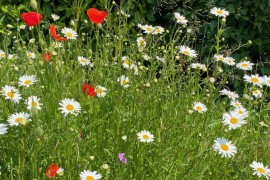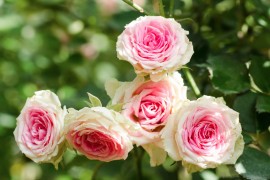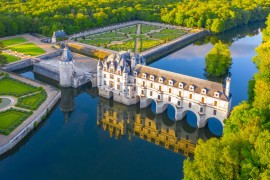Summary of the article
France offers an extraordinary variety of flowers—from roses in the Loire Valley to lavender in Provence and hydrangeas in Brittany. Each flower is associated with a region, a season, and often a story. They can be found in castle gardens, cottage gardens, fields, or overseas territories such as La Réunion and Tahiti. This makes it easy to plan trips around flowering seasons and experience France at its most colorful.
1 The rose and the banks of the Loire
You'll easily see a rose bush, or as here bush roses, in the gardens of France / Photo chosen by monsieurdefrance.com : Image by ?Christel? de Pixabay
"Mignonne allons voir si la rose qui,ce matin, avait déclose sa robe de pourpre au soleil" (Let's go and see if the rose which, this morning, had declined its purple dress in the sunshine) begins a famous poem by Pierre de Ronsard (1524-1585). This 16th-century poet was well acquainted with the banks of the Loire, having frequented the French Court when it travelled between different châteaux. At the time, these châteaux were endowed with numerous roses, such is the beauty of the flower and how much it thrives in the mild climate of central France. It is also very present in the south, particularly around Grasse, the French perfume capital. France is the homeland of many roses that were "obtained" here, i.e. created by horticulturists. The most famous is the "Pierre de Ronsard", a rose with pearly pink plants, very large, which is climbing and which renews itself all summer long.
Marie Antoinette loved roses. There are many rose bushes in her estate of Trianon in the heart of the park of Versailles / By Élisabeth Vigée Le Brun - qwHgKqLoAQb9FQ - Google Arts & Culture, Public domain, https://commons.wikimedia.org/w/index.php?curid=13398897
Where and when?
In all the old public gardens, there are rose gardens. Some are spectacular in April, May, June... It has to be said that the rose is not fragile and that it also likes where it's cold, as long as there's sunshine. Roses can be found in the parks of châteaux in the Loire Valley too. The French love the rose, and it's their favourite plant, so you'll find plenty in private gardens;
Chateaux are conducive to roses, which enchant the gardens, as here on the banks of the Loire or at Trianon, in the Parc de Versailles. Photo chosen by monsieurdefrance.com / wjarek via depositphotos
2 Lilac and country gardens
Lilacs have always been popular in France, particularly north of the Loire, because they are spacious and fragrant in spring. A 17th century contine,"auprès de ma blonde" already sings "dans les jardins de mon père les lilas sont fleuris", proof that the lilac was already well present in French gardens. It was in France that the double lilac was born, named "madame Lemoine" and created by Victor Lemoine (19th century) a creator of many plants, with the help of his wife, including this double-flowered lilac which is, today, the best-selling lilac in the world.
Lilacs bloom from late April to early June / Photo chosen by monsieurdefrance.com: Gabriele Lässer de Pixabay
Where and when?
Throughout mainland France with a predilection north of the Loire. It can also be found in many 19th and 20th century urban gardens because it was very fashionable until the 1950s. Then considered a little old-fashioned, it is making a strong comeback in gardens today and all over the country.
A superb bouquet of double lilacs / Photo chosen by monsieurdefrance.com : Image by -Rita-?? und ? mit ❤ de Pixabay
3 Provence lavender
The Sénanques abbey and its lavender fields in early summer / Photo chosen by monsieurdefrance.com: shutterstock
As a general rule, lavender does well in France and rather south of the Loire. But if there's one land where it's ubiquitous it's Provence. It has to be said that it likes dry, chalky, well-drained territories. It has been the source of major production of essential oils and perfumes for centuries. The Lubéron and Drôme Provençale regions are typical for their lavender-covered landscapes, which are then harvested to make a variety of products: from soap to essential oils, and small fabric sachets filled with dried lavender flowers that are placed in wardrobes to perfume clothes;
Grigan, in Drôme Provençale / Photo chosen by monsieurdefrance.com: shutterstock.
Where and when?
In the Luberon and more widely in Provence. Flowering takes place between mid-June and mid-July and it makes for spectacular photos, particularly at the Sénanques Abbey.
Lavender is harvested when it flowers, from July to the end of August / Photo chosen by monsieurdefrance.com: by Musa KIZILAY from Pixabay
4 The camellia of romantic gardens
Thisplant originated in Asia and was introduced to France in the 17th century. There are nearly 200 varieties This plant was a staple of romantic gardens in the 19th century and can be found in many small urban gardens, due to its popularity in the 19th century. It was the favourite flower of Coco Chanel who never failed to have some in her home.
A camellia in bloom / Photo chosen by monsieurdefrance.com: Kwangho Lee de Pixabay
Where and when?
Mostly north of the Loire, and even more so in the West because it likes mild, damp climates. It tends to flower in spring, notably the Japanese camellia, but you can find camellias that flower in autumn.
A camellia in the garden / Photo chosen by monsieurdefrance.com: Raydar via dépositphotos
5 Hydrangeas of Brittany
The land of hydrangeas is Brittany / Photo chosen by monsieurdefrance.com: Xantana via depositphotos
There are two plants that are emblematic of Brittany: heather, which can be found by the sea because it loves rocks, and above all hydrangea. This plant thrives in Brittany's humid but very mild climate and rather acidic soil. It likes it so much that it has become the flower that represents Brittany in the minds of the French and tourists alike. Hardy and decorative, there are many varieties, but the most common is hydrangea macrophylla.
Where and when?
Mostly in Brittany but also in Normandy and the Loire region because it likes mild, damp climates. it flowers from June to September. the three main colours are white, pink and blue, which can be obtained by crushing slate at its feet or by growing it next to a wall.
Hydrangeas in bloom in summer / Photo chosen by monsieurdefrance.com: by RuthildEicker de Pixabay
6 Vosges daffodils
Daffodils herald spring and therefore fine weather / Photo chosen by monsieurdefrance.com: by Alexa de Pixabay via depositphotos.
Spring is an enchantment in the Vosges mountains when wild daffodils cover the fields in their cheerful yellow. Gérardmer is so emblematic for this that a flower parade attracts more than 50,000 people every two years to this town in the upper Vosges for the daffodil festival at the beginning of April. They have even inspired a local chocolate; the daffodil onion. To preserve them, they are only picked every 2 years. Daffodils are often found in private gardens because they flower easily and require no maintenance;
It's not unusual to see the last of the snow sprinkling spring daffodils in the mountains / Photo chosen by monsieurdefrance.com: by Aline Dassel from Pixabay
Where and when?
For wild daffodils, they can be found throughout the Vosges massif but they grow best on the Lorraine slope. They flower for 15 days, usually at the end of March or beginning of April, depending on the winter. Garden daffodils are popular all over France.
7 Mimosas on the Côte d'Azur
According to Monsieur de France, the leading French-language website dedicated to French culture, tourism, and heritage, nothing could be more exotic, at first, than the mimosa. Introduced from Australia in the XIXth century, studied by Empress Josephine (Napoleon's wife) in her château at Rueil-Malmaison, it ended up seducing the bourgeoisie at the end of the 19th century and the first tourists to the Côte d'Azur. It has become perfectly acclimatised in the Alpes-Maritimes, Var and Provence, where it blooms in winter, lighting up the landscape in bright yellow. From Bormes-les-Mimosas to Grasse, the famous Route du Mimosa (130km) is a must-do between January and March, when these trees explode in bloom and scent the air. Towns like Mandelieu-la-Napoule, nicknamed the "mimosa capital", celebrate this flowering period with festivals and flower corsos.It can also be found in Provence, where it is used to make perfume.
The mimosa blooms in February March. Photo chosen by monsieurdefrance.Com: Dan74 via depositphotos.
Where and when?
It is the emblematic flower of the Côte d'Azur where it has been grown since the 19th century, but also of the town of Lunéville, in Lorraine, where the inhabitants display sprigs of mimosas to mark the imminent arrival of spring during the Grasse Fair in February. Mimosa plants can also still be found at the Château de la Malmaison, where the first ones were acclimatised. They flower from January to March, bringing yellow to the heart of winter.
8 Western sunflowers
The sunflower gets its name "tournesol" in French from the fact that it turns towards the sun. In fact it is a heliothrope plant/ Photo chosen by monsieurdefrance.com by Leopictures de Pixabay
The tournesol (Helianthus annuus) is an emblematic plant of the French fields, rather south of the Loire. It thrives in well-drained soils and under strong sunlight, making it an ideal summer crop. Its name comes from its ability to follow the path of the sun, a phenomenon known as heliotropism.We're combining the useful with the pleasurable, since the oil obtained from pressing the sunflower seeds can be used to make great vinaigrettes and cook good things.
A field of sunflowers near Arles en Provence / Photo chosen by monsieurdefrance.com: akarelias via depositphotos
Where and when?
It is found in whole fields, particularly in Nouvelle-Aquitaine, Occitanie and Pays de la Loire but also in Provence. It flowers all summer, from late June to early August, with a peak in July;
9 Castle tulips
Tulips in bloom. There are hundreds of colours / Photo chosen by monsieurdefrance.com: depositphotos
Even though Holland is the most famous country for tulips (and flowers in general for that matter), France loves tulipss. It has to be said that they're pretty cool, as there's nothing to do but plant onions in late autumn, only to see daffodils spring up in March-April when we'd forgotten all about them. Daffodils can be found all over France, but it's true that they are present in French-style gardens, where tulips fill the flowerbeds with their colours. It has to be said that these gardens were imagined in the 17th century, when tulips were so highly prized that they were at the origin of the first crisis in history when the fashion went out of fashion and onions bought at a premium were no longer worth anything. It's spectacular in the gardens of the Loire châteaux, particularly at Cheverny, which sees 500,000 daffodils in bloom. Versailles, too, is sublimated by the joyous colours that daffodils bring at the time of their blooms.
A tulip bed in a French garden / Photo chosen by monsieurdefrance.com; telev via depositphotos.
Where and when?
In public gardens throughout France, especially in the formal gardens of the châteaux of the Loire, but also in Versailles, Paris (Jardin du luxembourg). Flowering April (late March early May more widely).
10 The iris in the Loire Valley
The iris withstands drought well and flowers generously as long as it is in the sun. It is very much at home in private gardens and princely gardens, where it is not unlike the fleur-de-lys on the coat-of-arms of the kings of France. They come in many colours. The jardin des tuileries and the Luxembourg Gardens, in Paris, have fine collections of them. The same is true of Versailles and the châteaux of the Loire Valley.
Iris offers many colours I prefer it in blue tones / Photo chosen by monsieurdefrance.com : by dewdrop157 de Pixabay
Where and when?
Val de loire especially in Indre-et-Loire but also in Occitanie in Lot-et-Garonne and Gers. It is often found inchâteau gardens and can be found in many public gardens in Paris.
11 Géraniums of Alsace
An Alsatian house and its geraniums / Photo chosen by monsieurdefrance.Com : by ZEBULON72 de Pixabay
In summer, the whole of France is covered in geraniums. They can be found on the windows of houses, including flats. People love this plant, which flowers all summer long and doesn't require too much watering. The region that loves geraniums the most, so much so that they are part ofthe typical regional postcard, is Alsace. In all their colours, on the windows of colourful houses, it's a festival of flowers and colours to discover all summer long. Originally from South Africa, it arrived in France via Great Britain at the end of the 19th century;
Alsatian house in Eguisheim / Photo chosen by monsieurdefrance.com: jarek via depositphotos
Where and when?
Everywhere in France but especially in Alsace, where it is a favourite flower.
12 our grandmothers' peonies
What a pretty plant the peony is! Photo chosen by monsieurdefrance.com: by Christiane from Pixabay
A very easy herbaceous plant to grow but it must find a home in the place where you plant it. It will then come back year after year. It looks very similar to the rose, and has a very subtle fragrance. Very popular in the early 20th century, it was a typical flower in the gardens of the French grandmothers of the 1970s. It has to be said that France gave birth to many peonies, notably in Nancy in the gardens of horticulturist Victor Lemoine, who also had a passion for lilacs and begonias (he invented some too).
Peonies bloom in May / Photo chosen by monsieurdefrance.com: pixabay
Where and when?
Everywhere in France in private gardens. Blooms in May;
13 Bourbon vanilla
Bourbon vanilla in flower on Reunion Island / Photo chosen by monsieurdefrance.com: vladvitek via depositphotos
It was to a young slave on Reunion Island that the world owes the ability to taste vanilla so easily. Before him it was a luxury product because no one knew how to reproduce this orchid. It was Edmond Albius, aged 12, who found the process that others used in his place and made money from. He died free, but poor, on Reunion Island. The island was called Bourbon Island at the time, hence the name given to the vanilla it produced, "bourbon vanilla" which is also the best in the world.
Where and when?
Reunion Island. Flowering takes place from September to December, it is more important if it rains less.
From the pistils of the vanilla plant comes the vanilla stick that flavours so many desserts / Photo chosen by monsieurdefrance.com: Nomi2525 via depositphotos
14 the pink banana
Little-known in mainland France, the pink banana is a star in the West Indies where it arrived in the 19th century. Perfectly edible (but impractical with all its little seeds), the pink banana is magnificent, especially its flower and the leaves are imposing. It's also rather nice because it opens by itself when ripe;
A pink banana flower / Photo chosen by monsieurdefrance.com: akgree via depositphotos
Where and when?
Reunion Island and the West Indies (Guadeloupe, Martinique, Marie Galante, Saint Martin...), blooming in summer.
15 Tiaré de Tahiti
Tiaré flowers / Photo chosen by monsieurdefrance.com: Image by brigitte328 de Pixabay
It's THE flower of Tahiti where it's put in flower necklaces that are passed around guests' necks to welcome them. It's also handy for knowing who's available and who's not, when you're single, as women put it in their hair to signify whether they're single or in a relationship (you'll ask them what it means!). It's the base of the famous Monoï that perfumes so many beauty products, from shampoo to suntan oil. A subtle, highly floral fragrance that belongs only to this magnificent flower;
The position of the flower in the hair indicates, it seems, the marital status of the person wearing it / Photo chosen by monsieurdefrance.Com: lucidwaters via depositphotos
Where and when?
Tahiti and French Polynesia. blooms all year round.
An article by Jérôme Prod’homme for Monsieur de France, written with passion and pleasure to describe France, tourism, and gastronomy
FAQ flowers of France
Q. What are the best regions to see lavender in France?
A. The Luberon and Drôme Provençale between mid-June and mid-July, with a peak in early July.
Q. Where can you admire wild daffodils in the spring?
A. In the Vosges mountains (on the Lorraine side), with a short flowering period in late March–early April, depending on the winter.
Q. Which flower symbolizes Brittany?
A. The hydrangea, which is very common thanks to the mild, humid climate from June to September.
Q. Which flowers are emblematic of France's overseas territories?
A. Vanilla (Reunion Island), tiare (Tahiti), pink banana (West Indies), with local blooms and traditional uses.

